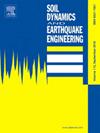Volumetric strain accumulation for saturated coral sand under various cyclic loading patterns
IF 4.2
2区 工程技术
Q1 ENGINEERING, GEOLOGICAL
引用次数: 0
Abstract
Seismic events and wave action can induce volumetric strain (εv) accumulation in saturated sandy soils, leading to damage to the ground surface and structures. A quantifiable relationship exists between the generation of εv in sandy soils under drained conditions and the development of pore water pressures under undrained conditions. In this study, the impact of relative density (Dr), cyclic stress path, and stress level on the characteristics of volumetric strain (εv) generation in saturated coral sands (SCS) was evaluated through drained tests employing various cyclic stress paths. The test findings demonstrate that the rate of εv accumulation in SCS is notably affected by the cyclic stress path. The rise in peak volumetric strain (εvp) in SCS, as a function of the number of cycles, conforms to the arctangent function model. The unit cyclic stress ratio (USR) was employed as an indicator of complex cyclic loading levels. It was determined that coefficient (εvp)u is positively correlated with USR at a specific Dr. At the same Dr, coefficient CN1 exhibits a positive correlation with USR, while coefficient CN2 displays a negative correlation with USR, following a power-law relationship. Irrespective of cyclic loading conditions, εvp rises with an increase in generalized shear strain amplitude (γga). A power function model was established to represent the relationship between εvp and γga. The coefficient ζ1 decreases as Dr increases. Comparisons were drawn between εvp and γga for Ottawa sand and SCS. The results indicate that, as Dr of Ottawa sand increases from 30 % to 70 %, the coefficient ζ1 decreases from 1.54 to 0.73, representing a reduction of approximately 53 %. In contrast, under identical conditions, the coefficient ζ1 of SCS exhibits a less pronounced decrease, from 1.16 to 0.79, corresponding to a reduction of roughly 32 %. These observations suggest that variations in Dr have a more substantial impact on generating εvp in Ottawa sand compared to SCS.
求助全文
约1分钟内获得全文
求助全文
来源期刊

Soil Dynamics and Earthquake Engineering
工程技术-地球科学综合
CiteScore
7.50
自引率
15.00%
发文量
446
审稿时长
8 months
期刊介绍:
The journal aims to encourage and enhance the role of mechanics and other disciplines as they relate to earthquake engineering by providing opportunities for the publication of the work of applied mathematicians, engineers and other applied scientists involved in solving problems closely related to the field of earthquake engineering and geotechnical earthquake engineering.
Emphasis is placed on new concepts and techniques, but case histories will also be published if they enhance the presentation and understanding of new technical concepts.
 求助内容:
求助内容: 应助结果提醒方式:
应助结果提醒方式:


